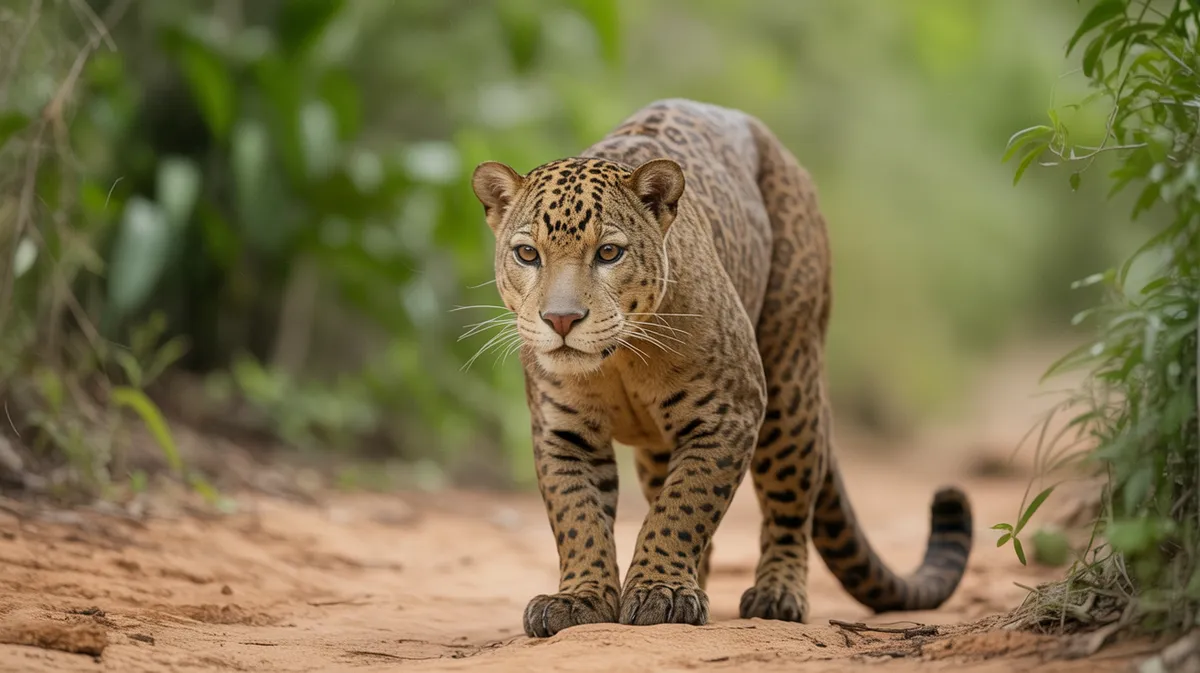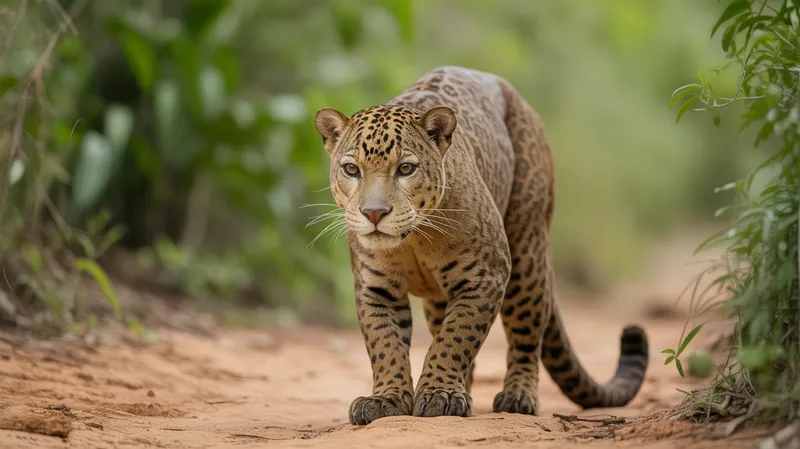
Jaguarundi
Herpailurus yagouaroundi

Meet the Jaguarundi
The jaguarundi is a small, slender wild cat native to Central and South America, easily recognized by its elongated body, short legs, and rounded ears. Its fur is typically uniform in color, ranging from grayish to reddish-brown, which helps it blend seamlessly into dense underbrush. Unlike many other wild cats, the jaguarundi is diurnal, being most active during the day, and is known for its agility both in trees and on the ground. Adaptable and elusive, it occupies a wide range of habitats, from lowland forests to savannas and even scrublands.
Classification
Mammal
Habitat
Dense forest, scrubland, savanna, and wetland edges
Diet
Carnivore
Lifespan
7-13 years
Conservation
Least Concern
Weight
3.5-9 kg
📖Fascinating Facts
Daytime Hunter
Unlike most small wild cats, the jaguarundi is primarily active during daylight hours, making it diurnal.
Varied Diet
Jaguarundis hunt a wide range of prey, including small mammals, birds, reptiles, frogs, and even fish.
Habitat Generalist
This species is highly adaptable and can thrive in forests, savannas, lowland brush, and even agricultural areas.
📋Detailed Description
The jaguarundi (Herpailurus yagouaroundi) is a medium-sized neotropical felid distinguished by its elongated, weasel-like body, short limbs, and long, tapering tail, which can account for up to 60% of its total body length. Adults typically measure 50–77 cm (20–30 in) in body length, with tails of 31–60 cm (12–24 in), and weigh between 3.5 and 7 kg (7.7–15.4 lb). The head is small and flattened, with short, rounded ears and a relatively short snout, giving the species a unique profile among wild cats. Its pelage is short, dense, and unspotted, exhibiting two main color morphs: a grayish-black phase and a reddish-brown phase, both of which can occur within the same litter. Jaguarundis are highly agile, capable of climbing trees and swimming, but they are primarily terrestrial and prefer to hunt on the ground. Their vision and hearing are well-developed, aiding in the detection of prey in dense vegetation. Unlike most felids, jaguarundis are diurnal, with peak activity during early morning and late afternoon. Solitary by nature, they maintain large home ranges, which can overlap slightly with those of conspecifics. Their vocal repertoire is unusually broad for a small cat, including whistles, chirps, and even bird-like calls, reflecting their complex communication needs in dense habitats.
💡 Did you know?
Despite their name and appearance, jaguarundis are more closely related to cougars than to jaguars.
🔬Research & Sources
Wikipedia Summary
The jaguarundi is a wild cat native to the Americas. Its range extends from central Argentina in the south to northern Mexico, through Central and South America east of the Andes. The jaguarundi is a medium-sized cat of slender build. Its coloration is uniform with two color morphs, gray and red. It has an elongated body, with relatively short legs, a small, narrow head, small, round ears, a short snout, and a long tail, resembling mustelids in these respects. It is about twice as large as a domestic cat, reaching nearly 360 mm (14 in) at the shoulder, and weighs 3.5–7 kg (7.7–15.4 lb).
Last Modified: 5/24/2025
🎭Behavior & Social Structure
Jaguarundis are predominantly solitary and territorial, marking their ranges with scent glands and feces. They are highly active during daylight hours, especially at dawn and dusk, and spend much of their time patrolling or hunting within their home ranges, which can span 6–100 km² depending on habitat quality. Their diet is opportunistic and varied, consisting mainly of small mammals (rodents, rabbits), birds, reptiles, amphibians, and occasionally fish and large insects. They are adept at hunting both on the ground and in low vegetation, employing stealth and rapid bursts of speed to capture prey. Unlike many other felids, jaguarundis are known to be relatively tolerant of water, sometimes swimming across rivers or foraging along streams. Social interactions are rare outside of the breeding season, but mothers are attentive to their young, and vocalizations are used for communication between individuals, especially during mating or between mothers and kittens.
👶Reproduction & Life Cycle
Jaguarundis are polyestrous and can breed year-round, though in some regions, births peak during the rainy season when prey is more abundant. Courtship involves vocalizations and scent marking, and copulation can occur multiple times over several days. After a gestation period of approximately 70–75 days, females give birth to litters of 1–4 kittens, typically in dense cover or hollow logs. The kittens are born blind and helpless, opening their eyes at around two weeks of age. Weaning occurs at about six weeks, but juveniles may remain with the mother for several months, learning hunting skills before dispersing to establish their own territories. Sexual maturity is reached at 2–3 years of age.
🛡️Adaptations & Survival
The jaguarundi's elongated, low-slung body and short legs are evolutionary adaptations for moving swiftly through dense undergrowth and thickets. Its unspotted, uniform coat provides effective camouflage in a range of habitats, from forests to savannas. The species' diurnal habits reduce competition with sympatric nocturnal felids such as ocelots and margays. Its broad diet and opportunistic feeding behavior allow it to exploit a wide variety of prey, contributing to its ecological flexibility. The jaguarundi's vocal versatility is unusual among small cats and may facilitate communication in visually obstructed environments. Additionally, its tolerance for disturbed habitats and edge environments enables it to persist in areas affected by human activity, although it is sensitive to large-scale habitat fragmentation.
📚Research Sources
🎨Cultural Significance
The jaguarundi has a relatively minor role in indigenous folklore compared to larger felids like the jaguar or puma. However, in some regions of Central and South America, it is associated with agility and stealth, and its unusual appearance has led to various local names (e.g., 'otter cat', 'eyra cat'). Occasionally, it has been kept as a pet or for rodent control, though this is discouraged due to its wild nature and conservation status. Unlike some other wild cats, it is not commonly targeted for its fur.
🔬Recent Research & Discoveries
Recent genetic studies have clarified the jaguarundi's taxonomic position, confirming it as a distinct genus (Herpailurus) closely related to the puma (Puma concolor), with divergence estimated at 3–4 million years ago. Ongoing research focuses on its ecological role as a mesopredator, its adaptability to fragmented landscapes, and the impacts of habitat corridors on gene flow. Camera trap and radio telemetry studies are providing new insights into its spatial ecology and activity patterns. Conservation genetics is also a growing field, aiming to assess population connectivity and inbreeding risks, especially in isolated populations.
🎥Wildlife Videos

The jaguarundi, the unknown cat of Latin America
We carried out a large collaborative study, assessing the status of one of the unknown cats of Latin America, the jaguarundi ...
Wild Cat Science

Jaguarundi is the Rarest and Strangest Cat
This is auto-dubbing into different languages. Our original channel "Planet Earth": https://www.youtube.com/@PlanetEarth1984 ...
PLANET EARTH

Shadow Cat: One Of The Rarest Cats In The World
This elusive small cat is the shadow of South and Central America. Check out Basepaws at https://basepaws.com/animalogic and ...
Animalogic

Otter In The Amazon Resembles Jaguarundi | Creatures Of The Magic Water
In the north of Brazil where the River Negro and the mighty Amazon meet, virgin rainforest covers the landscape for hundreds of ...
Real Wild

Discover the Enigmatic Jaguarundi!
Join us in this captivating video as we explore the life of the Jaguarundi, one of nature's most elusive wild cats! With its sleek body ...
Happy Learners and Minds

Sand Cat: The King of the Desert
Sand Cats may not look the part, but they are built to handle the extremes of one of the harshest environments on Earth. Support ...
Animalogic
🌍Habitat Information
The Jaguarundi typically inhabits Dense forest, scrubland, savanna, and wetland edges environments. Jaguarundis have adapted to their environments with specialized features and behaviors.
Primary Habitat:
Dense forest, scrubland, savanna, and wetland edges
More detailed habitat information will be available soon.
🛡️Conservation Status
The Jaguarundi is currently classified as Least Concern. Conservation efforts are crucial for preserving this species for future generations.
Common Threats:
- 🏠Habitat loss and fragmentation
- 🌡️Climate change impacts
- 🎯Hunting and poaching
- 🏭Human-wildlife conflict
⚠️Threats & Conservation Challenges
While the jaguarundi is currently listed as Least Concern by the IUCN, its populations are believed to be declining due to habitat loss, fragmentation, and degradation, particularly from agricultural expansion, deforestation, and urbanization. Road mortality and persecution by humans, often in retaliation for poultry predation, also pose localized threats. The species is sensitive to the loss of dense cover and large, contiguous habitats, making it vulnerable in regions where forests are being cleared. In some areas, the jaguarundi has disappeared entirely, especially at the northern and southern extremes of its range. There is limited data on population densities, and the species is often under-recorded in camera trap surveys due to its elusive nature.
🔬Scientific Classification
Scientific Name
Herpailurus yagouaroundi
Classification Hierarchy
🔍 About Taxonomic Classification
Taxonomic classification is a hierarchical system used by scientists to classify and organize living organisms based on shared characteristics and evolutionary relationships.
The system moves from broad categories (Kingdom) to increasingly specific ones, with each animal's scientific name typically consisting of its Genus and species.
📝Community Notes
Share your observations and insights about the Jaguarundi with our community of wildlife enthusiasts.
Join Our Community
Sign in to share your observations and connect with fellow wildlife enthusiasts.
Sign In to ContributeNo community notes yet
Be the first to share your observations about the Jaguarundi!
Explore Jaguarundi
Select a tab above to learn more about this amazing animal.
📸Photo Gallery
No photos available for this animal yet.
🌟Discover More Wildlife
Continue your journey of discovery with more fascinating animals from our database
